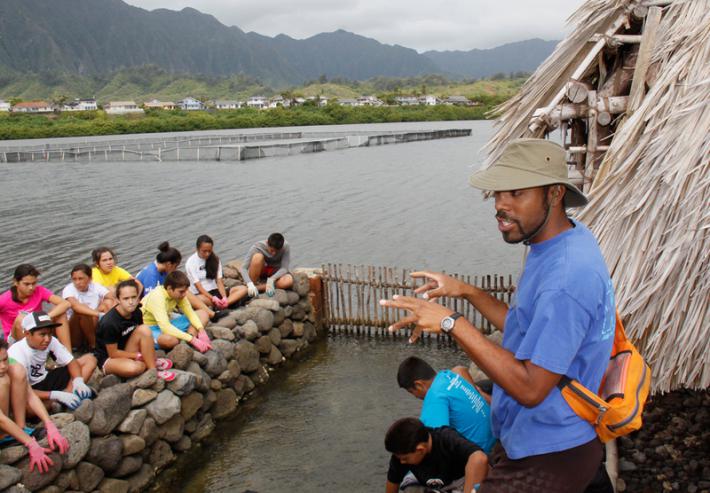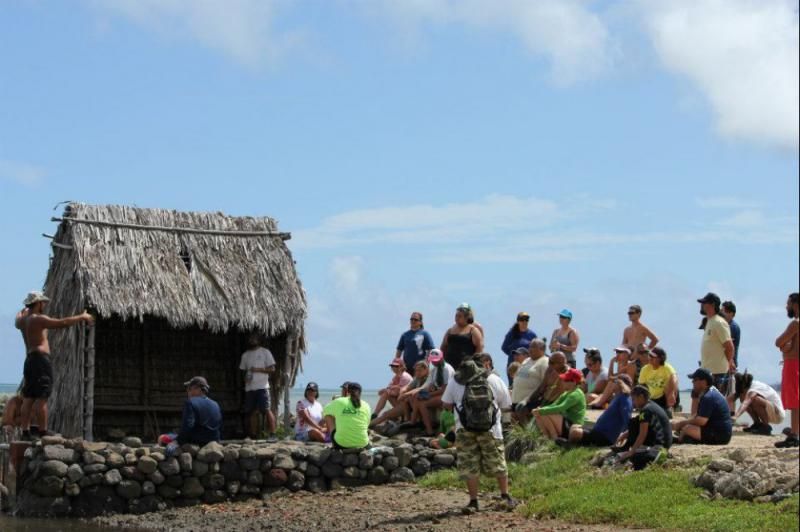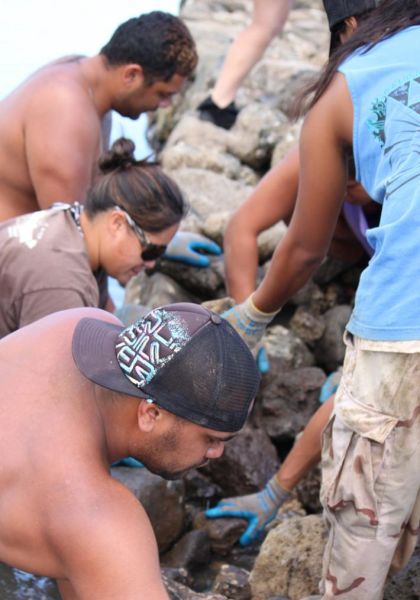Digital Collections
Celebrating the breadth and depth of Hawaiian knowledge. Amplifying Pacific voices of resiliency and hope. Recording the wisdom of past and present to help shape our future.
Melehina Groves
‘A‘ohe hana nui ke alu ‘ia.
No task is too big when done together by all.
(Kawena Pukui, ‘Ōlelo No‘eau, 142)
I am slightly embarrassed to admit that although I have lived in He‘eia for over 20 years, I had never visited ka loko i‘a ‘o He‘eia (He‘eia fishpond) until early this January when I was welcomed by Mahina Paishon Duarte and Ānuenue Punua of Paepae ‘o He‘eia, a non-profit organization that is responsible for overseeing the loko i‘a (fishpond). Ānuenue, who is the Education Coordinator for the program and has been involved with the loko i‘a for the last nine years, soothed my conscience a bit by sharing that she grew up in the neighboring ahupua‘a of Kāne‘ohe and was also unaware of the ancient site that lay just a few minutes away! Today, thanks to the efforts of dedicated members of Paepae ‘o He‘eia and their supporters, things are starting to change!
Formed in 2001, Paepae ‘o He‘eia works to coordinate educational activities at ka loko i‘a ‘o He‘eia through an agreement with ‘Āina ‘Ulu of Kamehameha Schools. Their mission is to implement values and concepts from the model of a traditional loko i‘a to provide physical, intellectual, and spiritual sustenance for the community.
Mahina has been involved with the loko i‘a for the past ten years and is now the Executive Director of Paepae ‘o He‘eia. Mahina explained that it is more than just a piece of living history: the loko i‘a can be an "ideal place for science and culture, traditional and contemporary practices, and old and new idealogies to merge—all combining for an enhanced learning environment. There are many different ways to approach culture; Paepae believes that in order for a culture to thrive, it must be dynamic and possess the capability to evolve."
One of the most valuable lessons to be taken from the loko i‘a involves this bridging of tradition and modernity. It is not necessary for students to abandon traditional knowledge or ancestral ways to succeed in today’s world.
"The loko i‘a teaches students that their culture is still alive and there for them to learn from. It’s ancient, and it’s still here," Ānuenue continued. There are currently three Hawai‘i Public Charter Schools who visit weekly: Ke Kula ‘o Samuel M. Kamakau Laboratory School, Hakipu‘u Learning Center, and Hālau Kū Mana. Through their work at the loko i‘a, students are introduced to the concepts of mālama ‘āina (caring for the land) and kōkua (helping those around you), while vital subjects such as math, science, and history are integrated into the experience.
"The loko i‘a makes science fun and interesting for the students. It’s something they can understand and latch on to," Mahina explained.
There are also several initiatives in place at the loko i‘a which help to realize Paepae ‘o He‘eia’s mission. Three key programs are "Ka ‘Ai Kamaha‘o," "Kū Hou Kuapā," and "‘Āina Momona," all strategically developed to further the curriculum of the program’s participants and help to achieve the organization’s goals.
Mahina identified how each program is unique and designed with a specific purpose in mind. "Ka ‘Ai Kamaha‘o" focuses on eco-cultural education. Each project presents students with culturally relevant and academically rigorous learning situations, providing a living lab for the transmission of traditional and contemporary knowledge and skills. For example, students may conduct a place-specific ecological study involving the moon phases as they directly affect the loko i‘a, examining the relationship between predator abundance, crab distribution, and water quality.
"For the children, the fishpond places value on learning about our kūpuna and their skills and knowledge, what they did and what we continue to do today because of them," said Ānuenue.
The value of fostering ‘ike kūpuna in a modern society is immeasurable, as evidenced in another "Ka ‘Ai Kamaha‘o" initiative called the ‘Ohana Project. This is a four-month program which most recently focused on families belonging to two Pūnana Leo schools. The main drive behind this program is reconnecting these ‘ohana with traditional methods of catching, preparing, and eating native mea ‘ai, such as pāpa‘i (crab.)
"They are engaged as an ‘ohana which is extremely valuable," Mahina explained, sharing one particularly memorable experience: three generations of the same ‘ohana participated in the program, where the kupuna wahine (grandmother) was given a venue to share her traditional knowledge of preparing and eating raw pāpa‘i with her daughter and granddaughter. This type of dynamic learning is what Paepae ‘o He‘eia works so hard to achieve. Besides Pūnana Leo and charter schools, several other entities have partnered under "Ka ‘Ai Kamaha‘o," including the Kamehameha Schools, OHA, King Intermediate, and the University of Hawai‘i at Mānoa.
"Kū Hou Kuapā" is a partnership with the Kamehameha Schools which focuses on the physical upkeep of the loko i‘a’s traditional infrastructure, refurbishing and maintaining the kuapā (seawalls) and mākahā (gates and sluice gates). Every second and fourth Saturday of the month is a community workday when individuals or groups can come in and lend a hand to the restoration of the loko i‘a and the reduction of mangroves in the area—a daunting yet worthwhile endeavor! There is much to be gained beyond the walls of the loko i‘a, however, as involving the community in such a project can bring rewards far greater than anything material.
"There are so many levels of opportunities here—on the social development level, the community involvement level, the education level, as well as in the spiritual reconnection to working the land. This is all a process and in order to heal ourselves and our community, our people need to have these opportunities to work through challenges together," said Mahina.
"‘Āina Momona" works to not only heighten the public’s awareness of loko i‘a, but also to foster community-based economic development for their members and the greater Ko‘olaupoko Hawaiian community. In a partnership with NOAA, these types of projects strive to develop profitable services and products for the benefit of the larger population and the loko i‘a itself.
Loko i‘a have always been a community undertaking. Traditionally, their construction was a huge task and every family living in an ahupua‘a was expected to assist in the work and maintenance, thereby earning a right to the catch. Loko i‘a were very abundant in Hawai‘i and our kūpuna had mastered their construction and the use of mākahā to make catching fish even faster and more effective. There are also many mo‘olelo (stories) regarding the loko i‘a, some of which are told on Paepae o He‘eia’s website.
He‘eia is said to be an ideal location for a loko i‘a, as fresh water flows into it from He‘eia Stream and mixes with salt water from Kāne‘ohe Bay, resulting in brackish conditions and continuous replenishment of oxygen for i‘a and algae. The mixing of salt and fresh water is an excellent metaphor for the type of learning environment that is created at ka loko i‘a ‘o He‘eia—as both Mahina and Ānuenue have expressed, it is the meeting of traditional ‘ike and modern technological skills that make the loko i‘a such a dynamic place for students and the community as a whole.
Mahina stressed the importance of maintaining a personal relationship with the loko i‘a. "In our desire to serve the community and all the people involved with the loko i‘a, it can get really busy and we have to work to maintain pono within ourselves and remember to enjoy and experience what the loko i‘a has to offer, too."
"If things weren’t meant to be, we wouldn’t be where we are, the door would have been shut a long time ago," Ānuenue laughed, when I asked her if she had ever envisioned Paepae o He‘eia evolving out of the informal volunteering and aloha ‘āina that began nine years ago.
"Paepae" is literally a "support" or "prop," and that is exactly what the organization stands for. Mahina summarized her thoughts in this way, reflecting on the meaning of being a true paepae, "We aim to be the mākahā within our fishpond, the conduit between past, present, and future and the conduit for learning to occur in traditional and contemporary ways. We hope the whole purpose of the fishpond can be realized by us as a community working and learning together, improving the ‘āina and in turn improving ourselves."
Most of all, both women would like to thank the many supporters who have assisted them in becoming the paepae that they are—the loko i‘a is only as healthy as the ahupua‘a that surrounds it, in both the literal and figurative sense! As both Mahina and Ānuenue emphasized, if Paepae ‘o He‘eia is truly doing its job, the loko i‘a will be the real teacher, not them!
For more information about the loko i‘a, or if you or your group is interested in volunteering, please see their website for dates and availability!

photo credit: Ka Ipu o Lono
Staff member Keliʻi Kotubetey haumāna are introduced to mālama ʻāina (caring for the land).

photo credit: Ka Ipu o Lono
Learners and volunteers of all ages are welcome at Paepae o Heʻeia.

photo credit: Ka Ipu o Lono
Paepae o Heʻeia staff build the kuapā (fishpond wall).